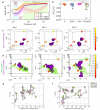Microrheology: From Video Microscopy to Optical Tweezers
- PMID: 40872425
- PMCID: PMC12388072
- DOI: 10.3390/mi16080918
Microrheology: From Video Microscopy to Optical Tweezers
Abstract
Microrheology, a branch of rheology, focuses on studying the flow and deformation of matter at micron length scales, enabling the characterization of materials using minute sample volumes. This review article explores the principles and advancements of microrheology, covering a range of techniques that infer the viscoelastic properties of soft materials from the motion of embedded tracer particles. Special emphasis is placed on methods employing optical tweezers, which have emerged as a powerful tool in both passive and active microrheology thanks to their exceptional force sensitivity and spatiotemporal resolution. The review also highlights complementary techniques such as video particle tracking, magnetic tweezers, dynamic light scattering, and atomic force microscopy. Applications across biology, materials science, and soft matter research are discussed, emphasizing the growing relevance of particle tracking microrheology and optical tweezers in probing microscale mechanics.
Keywords: atomic force microscopy; diffusing wave spectroscopy; dynamic light scattering; magnetic tweezers; microrheology; optical tweezers; rheology; video particle tracking.
Conflict of interest statement
The authors declare no conflicts of interest.
Figures






















References
-
- Einstein A. In: Investigations on the Theory of the Brownian Movement. Fürth R., editor. Dover Publications, Inc.; New York, NY, USA: 1956.
-
- Perrin J. Atoms. Constable; London, UK: 1916.
-
- Tassieri M. Microrheology with Optical Tweezers: Peaks & Troughs. Curr. Opin. Colloid Interface Sci. 2019;43:39–51. doi: 10.1016/j.cocis.2019.02.006. - DOI
Publication types
LinkOut - more resources
Full Text Sources

